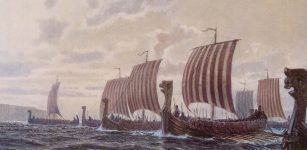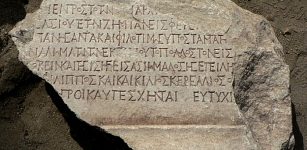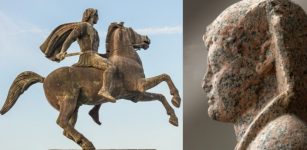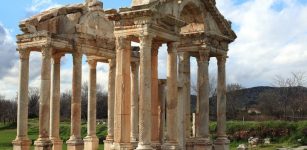Cyrus The Great Cylinder – Legacy Of The Ancients
A. Sutherland - AncientPages.com - The Cyrus Cylinder, sometimes referred to as the first “bill of human rights,” traces its origins to the Persian king Cyrus the Great’s conquest of Babylon in the sixth century B.C.
Almost 2,600 years later, its remarkable legacy continues to shape contemporary political debates, cultural rhetoric and philosophy.
One of the most celebrated objects in world history, the Cyrus cylinder is a fragmentary clay cylinder with an Akkadian inscription of thirty-five lines discovered in a foundation deposit by A. H. Rassam during his excavations at the site of the Marduk temple in Babylon in 1879.

In this text, a clay cylinder now in the British Museum, Cyrus describes how he conquers the old city. Nabonidus is considered a tyrant with strange religious ideas, which causes the god Marduk to intervene. That Cyrus thought of himself as chosen by a supreme god, is confirmed by Second Isaiah; h is claim that he entered the city without struggle corroborates the same statement in the Chronicle of Nabonidus.
A second fragment, containing lines 36-45, was later identified in the Babylonian collection at Yale University. The total inscription, though incomplete at the end, consists of forty-five lines, the first three almost entirely broken away.
The text contains an account of Cyrus’ conquest of Babylon in 539 B.C.E., beginning with a narrative by the Babylonian god Marduk of the crimes of Nabonidus, the last Chaldean king (lines 4-8).
Then follows an account of Marduk’s search for a righteous king, his appointment of Cyrus to rule all the world, and his causing Babylon to fall without a battle (lines 9-19). Cyrus continues in the first person, giving his titles and genealogy (lines 20-22) and declaring that he has guaranteed the peace of the country (lines 22-26), for which he and his son Cambyses have received the blessing of Marduk (lines 26-30).
He describes his restoration of the cult, which had been neglected during the reign of Nabonidus, and his permission to the exiled peoples to return to their homeland (lines 30-36). Finally, the king records his restoration of the defenses of Babylon (lines 36-43) and reports that in the course of the work he saw an inscription of Aššurbanipal (lines 43-45).
The Cylinder—a football-sized, barrel-shaped clay object covered in Babylonian cuneiform, one of the earliest written languages—announced Cyrus’ victory and his intention to allow freedom of worship to communities displaced by the defeated ruler Nabonidus. At the time, such declarations were not uncommon, but Cyrus’ was unique in its nature and scope.
When contextualized with other contemporary sources, such as the Bible’s Book of Ezra, it becomes evident that Cyrus allowed displaced Jews to return to Jerusalem.
“One of the goals of this exhibition is to encourage us to reflect that relations between Persians and Jews have not always been marked by the discord that disfigures the political map of the Near East today,” said Julian Raby, The Dame Jillian Sackler Director of the Arthur M. Sackler Gallery and the Freer Gallery of Art.
“Cyrus was the very image of a virtuous rule¬—inspiring leaders from Alexander the Great to Thomas Jefferson—so it is apt that the first time it will be seen in the West is in Washington, D.C.”
Under Cyrus (ca. 580–530 B.C.), the Persian Empire became the largest and most diverse the world had known to that point. Subsequent generations of rulers considered it to be the ideal example of unified governance across multiple cultures, languages and vast distances.
Cyrus’ declarations of tolerance, justice and religious freedom provided inspiration for generations of philosophers and policymakers, from Ancient Greece to the Renaissance, and from the Founding Fathers to modern-day Iran, so much so that a copy now resides in the United Nations’ headquarters in New York.
The message of the Cylinder and the larger legacy of Cyrus’ leadership have been appropriated and reinterpreted over millenia, beginning with its creators. The Babylonian scribe who engraved the Cylinder attributed Cyrus’ victory to the Babylonian god Marduk, a stroke of what could be considered royal and religious propaganda.
In the fourth century B.C., the Greek historian Xenophon wrote Cyropaedia, a text that romanticizes the philosophies and education of Cyrus as the ideal ruler, which greatly influenced both Alexander the Great and, much later, Thomas Jefferson in his creation of the Declaration of Independence.
Rediscovered in 1879, the document immediately entered the fray of public debate as invaluable proof of the historical veracity of events described in biblical scripture. In the early 20th century, supporters of the creation of the state of Israel compared the actions of British King George V to those of Cyrus, allowing Jews to return to Jerusalem.
“The Cyrus Cylinder and Ancient Persia” includes related objects that highlight some of the artistic, cultural and historical achievements of the Achaemenid Empire (550–330 B.C.) of Iran, such as architectural fragments, finely carved seals and luxury objects from the Oxus Treasure.
Written by – A. Sutherland AncientPages.com Senior Staff Writer
Copyright © AncientPages.com All rights reserved. This material may not be published, broadcast, rewritten or redistributed in whole or part without the express written permission of AncientPages.com
Expand for referencesMore From Ancient Pages
-
 Fate Of The Woman Whose Mysterious Doppelgänger Ruined Her Life
Featured Stories | Mar 6, 2023
Fate Of The Woman Whose Mysterious Doppelgänger Ruined Her Life
Featured Stories | Mar 6, 2023 -
 Riddle Of Orkney’s Lost Tomb – Fascinating Neolithic Discovery
Featured Stories | Nov 15, 2023
Riddle Of Orkney’s Lost Tomb – Fascinating Neolithic Discovery
Featured Stories | Nov 15, 2023 -
 Ten Ancient Jugs May Reveal The Location Of The Biblical Tabernacle
Archaeology | Jul 21, 2017
Ten Ancient Jugs May Reveal The Location Of The Biblical Tabernacle
Archaeology | Jul 21, 2017 -
 Huge Viking Winter Camp Unearthed In England
Archaeology | May 19, 2017
Huge Viking Winter Camp Unearthed In England
Archaeology | May 19, 2017 -
 Dead City Of Serjilla – Byzantine Village In Syria Struggling To Survive The Middle Of A War Zone
Featured Stories | Jan 27, 2020
Dead City Of Serjilla – Byzantine Village In Syria Struggling To Survive The Middle Of A War Zone
Featured Stories | Jan 27, 2020 -
 Slovenia’s Unique Discovery Of Masts, Sails And Small Harbor Found At The Bottom Of The Adriatic Sea
Archaeology | Apr 2, 2024
Slovenia’s Unique Discovery Of Masts, Sails And Small Harbor Found At The Bottom Of The Adriatic Sea
Archaeology | Apr 2, 2024 -
 Ancient Mystery Of Peculiar Nail With Six Faces And Six Eyes – Unusual Discovery In Borgholm Castle, Sweden
Artifacts | Jan 8, 2017
Ancient Mystery Of Peculiar Nail With Six Faces And Six Eyes – Unusual Discovery In Borgholm Castle, Sweden
Artifacts | Jan 8, 2017 -
 Aillén Mac Midgna: Evil Goblin Who Terrorized Sacred Hill Of Tara
Celtic Mythology | Mar 28, 2024
Aillén Mac Midgna: Evil Goblin Who Terrorized Sacred Hill Of Tara
Celtic Mythology | Mar 28, 2024 -
 Diyu – Terrible Chinese Hell And Judgement Of God Yama
Chinese Mythology | Dec 18, 2018
Diyu – Terrible Chinese Hell And Judgement Of God Yama
Chinese Mythology | Dec 18, 2018 -
 Tailteann Games: Ancient Irish Version Of The Olympic Games
Ancient History Facts | May 15, 2016
Tailteann Games: Ancient Irish Version Of The Olympic Games
Ancient History Facts | May 15, 2016 -
 Strange Mist, Unexplained Vanishings And Other Bizarre Incidents – What Is The Connection?
Featured Stories | Mar 8, 2019
Strange Mist, Unexplained Vanishings And Other Bizarre Incidents – What Is The Connection?
Featured Stories | Mar 8, 2019 -
 2nd Century Inscription Unearthed At Forum Of Ancient City Of Philippopolis, Bulgaria
Archaeology | Oct 21, 2019
2nd Century Inscription Unearthed At Forum Of Ancient City Of Philippopolis, Bulgaria
Archaeology | Oct 21, 2019 -
 Mysterious Ancient Female Society Discovered – What Happened To All The Men? Archaeologists Wonder
Featured Stories | Oct 3, 2024
Mysterious Ancient Female Society Discovered – What Happened To All The Men? Archaeologists Wonder
Featured Stories | Oct 3, 2024 -
 Seven Gods Of Happiness – Bring Luck, Prosperity And Health In Japanese Folk Belief
Featured Stories | Jun 29, 2020
Seven Gods Of Happiness – Bring Luck, Prosperity And Health In Japanese Folk Belief
Featured Stories | Jun 29, 2020 -
 Bronze Age Metal Cauldrons Show What Ancient People Ate
Archaeology | Aug 19, 2023
Bronze Age Metal Cauldrons Show What Ancient People Ate
Archaeology | Aug 19, 2023 -
 Alexander The Great Was Crowned Pharaoh And Declared Son Of God Amun
Ancient History Facts | Jan 4, 2019
Alexander The Great Was Crowned Pharaoh And Declared Son Of God Amun
Ancient History Facts | Jan 4, 2019 -
 What Can Archaeology Tells Us About Climate Change?
Archaeology | Aug 9, 2021
What Can Archaeology Tells Us About Climate Change?
Archaeology | Aug 9, 2021 -
 Can King Ashurbanipal’s Strange Clay Tablet Unravel The Mystery Of The Lunar Kings
Ancient Mysteries | Nov 9, 2021
Can King Ashurbanipal’s Strange Clay Tablet Unravel The Mystery Of The Lunar Kings
Ancient Mysteries | Nov 9, 2021 -
 Daily Life Of Ancient Maya
Ancient History Facts | Oct 12, 2020
Daily Life Of Ancient Maya
Ancient History Facts | Oct 12, 2020 -
 Unsolved Enigma Of The Lost Ancient City In The Kalahari Desert
Ancient Mysteries | Aug 29, 2015
Unsolved Enigma Of The Lost Ancient City In The Kalahari Desert
Ancient Mysteries | Aug 29, 2015



